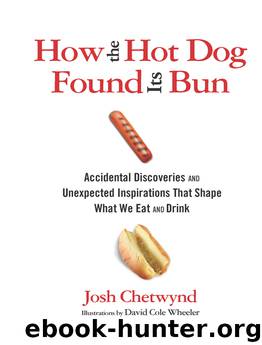How the Hot Dog Found Its Bun: Accidental Discoveries and Unexpected Inspirations That Shape What We Eat and Drink by Josh Chetwynd

Author:Josh Chetwynd [Chetwynd, Josh]
Language: eng
Format: epub
Tags: History, Reference, Curiosities & Wonders, Cooking, trivia buffs, Foodies, food facts, food fiction
ISBN: 9780762785285
Publisher: Globe Pequot
Published: 2012-05-01T06:46:06+00:00
Artificial Sweeteners: Sloppy scientists
You’d think that rule number one when working with chemical compounds in a lab would be don’t taste anything unless you’re absolutely certain what you’re putting in your mouth. After all, we even tell little kids on the playground to follow that rule. But for those who can’t get through the day without a Diet Pepsi or a Coke Zero, it’s fortunate that apparently many scientists aren’t too worried about following that childhood missive.
Each of the original holy trinity of artificial sweeteners—saccharin, cyclamate, and aspartame (aka NutraSweet)—was discovered by researchers who just didn’t think to wash their hands. As for the most recent, and today’s most popular, artificial sweetener, sucralose (known on the street as Splenda), it has its own different but equally accidental origin story.
Saccharin was the original sugar substitute. In 1879 one of the century’s most revered chemists, Ira Remsen, was doing research on coal tar derivatives. (If you wonder why saccharin has that awful aftertaste, coal derivatives might give you some sense.) During research, an associate, Constantin Fahlberg, accidentally spilled some of a substance he was preparing on his hands. Overcome by intellectual curiosity—rather than common sense—he took a lick and found it to be incredibly flavorful. It turned out that the mixture was 300 times as sweet as basic sugar. He named it saccharin after the Latin word for sugarcane, saccharum.
While saccharin went on the market as an alternative to sugar, its bitter aftertaste did somewhat limit its value. What was needed was another sweetener to mix with it that could lessen the bite. Cyclamate, which was discovered in 1937, wasn’t as sweet as saccharin, but proved to be its potential partner (though some studies have indicated the combo can cause cancer). Yet again, its discovery came from another messy scientist.
Michael Sveda was a student at the University of Illinois working on some sulfamates that were expected to have promising pharmacological properties. He got his hands dirty—so to speak—mixing these compounds and didn’t think anything of it when he went for a cigarette break. After taking a long drag from his smoke, he noticed something very odd: Chemicals on his hands from the experiments had soaked into the cigarette creating a sweet taste.
Proving that scientists don’t always learn from the past, James M. Schlatter had his own unclean story when it came to finding the combination that led to Equal and NutraSweet. In December 1965, after getting some aspartame powder on his hands, he licked a finger in order to help pick up a piece of paper. He noticed the strong sweet taste (some 200 times greater than sugar).
Shashikant Phadnis’s mistake, which led to Splenda, wasn’t a product of poor cleanliness. It was due to miscommunication. In 1975, the native of India was a student at Queen Elizabeth College in London working on an experiment with a highly toxic chemical called sulfuryl chloride. At one point in the proceedings, Phadnis’s adviser asked him to “test” his work. Maybe it was the professor’s British accent, but the student thought he said to “taste” his work.
Download
This site does not store any files on its server. We only index and link to content provided by other sites. Please contact the content providers to delete copyright contents if any and email us, we'll remove relevant links or contents immediately.
| Coloring Books for Grown-Ups | Humor |
| Movies | Performing Arts |
| Pop Culture | Puzzles & Games |
| Radio | Sheet Music & Scores |
| Television | Trivia & Fun Facts |
Atlas Obscura by Joshua Foer(2749)
The Earth Chronicles Handbook by Zecharia Sitchin(2141)
The Book Of Lists by Wallechinsky David & Wallace Amy(2061)
The Right Way to Do Wrong by Harry Houdini(1857)
Badass Affirmations by Becca Anderson(1819)
The Book of Common Fallacies by Philip Ward Julia Edwards(1560)
Elephants on Acid: And Other Bizarre Experiments by Alex Boese(1531)
Elephants on Acid by Boese Alex(1497)
The Mystery of the Exploding Teeth by Thomas Morris(1497)
Atlas of Improbable Places by Travis Elborough(1465)
A Christmas Cornucopia by Mark Forsyth(1394)
I'm So Full of Happy Today by Martin Andersen & Moira Tuffy(1384)
Big, Bad Book of Botany : The World's Most Fascinating Flora (9780062282767) by Largo Michael(1326)
The Mysteries of Mithra by Cumont Franz(1291)
Wild Talents by Charles Fort(1275)
Breaking History by Sarah Pruitt(1246)
How Things Are Made by Andrew Terranova & Sharon Rose(1208)
A Cookie to Celebrate by Jana Douglass(1167)
John A Keel by 2002 The Complete Guide to Mysterious Beings(1146)
